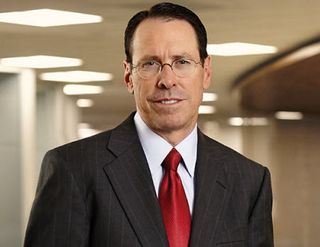AT&T Eyes ‘Wireless-Centric’ Video Offering for 2018

AT&T will begin beta testing a “wireless-centric,” direct-to-home video offering built off its DirecTV Now service in the fourth quarter, with an eye toward a full launch next year, CEO Randall Stephenson told an industry audience Tuesday.
Stephenson, at the Goldman Sachs Communacopia conference in New York, said that AT&T has been moving in this direction since it purchased satellite TV provider DirecTV in 2015. That purchase, Stephenson said, allowed the company to obtain wireless distribution rights to DirecTV’s content in record time. A year after the purchase, DirecTV launched an over-the-top product dubbed DirecTV Now at a lower price point than traditional pay TV services.
READ MORE: Comcast's Roberts tries to calm investors
Pay TV subscribers have been on the decline for years – the second quarter was the worst ever for pay TV companies, which shed more than 900,000 video customers in the period. Stephenson said that with average monthly revenue per pay TV customer well above $100, the reason should come as no surprise.
“It’s a price issue,” Stephenson said of the decline. “Content costs continue to escalate, prices on the cable bundle continue to go up, so people are opting out of the cable bundle.”
He estimated that 20 million households have shed their cable service in the past several years, adding that those who are cutting the cord are younger and tend to live in apartment complexes, an ideal environment for an internet-based video offering.
“We concluded early on you need a wireless-centric approach to that market,” Stephenson said. “As soon as we closed DirecTV, we went to work getting the rights of all the content to deliver to a mobile device, it was the main benefit that came with DirecTV. And we were able to get these rights in very short order. Within a year we were standing up DirecTV Now, this is not a $115 bundle of content, this is a $30-to-$60 bundle of content. Here is a much lower-priced bundle of content that is well integrated with our wireless service, it’s created a very unique and I think compelling value proposition in the market.”
Wireless video delivery has been seen as the future for pay TV as more and more people regularly watch content on mobile devices. But streaming services have run into capacity issues as traffic increases. DirecTV Now notoriously ran into service issues after its initial launch, and streaming problems are commonplace during popular events – most recently the Mayweather-McGregor Pay-Per-View boxing match, where thousands of customers that paid to stream the fight last month via the Showtime app couldn’t access it.
Multichannel Newsletter
The smarter way to stay on top of the multichannel video marketplace. Sign up below.
Stephenson said the key to reliably deliver these new services is to consistently deliver 1 Gigabit per second data speeds.
READ MORE: Rutledge says Charter is not fighting OTT video
AT&T is on a trajectory that moves it toward 1 Gigabit per second data speeds and has sufficient spectrum to handle capacity issues. 5G technology, expected to be widely deployed in the next two years – will address the problem.
Despite those issues, Stephenson said the software-based solution will be the platform on which AT&T delivers all video in the future because it delivers video efficiently and at a lower cost which can then be passed to the customer.
Stephenson also talked about the pending merger with Time Warner Inc., which the company hopes to receive regulatory approval for by the end of the year. Stephenson reiterated that he intends to keep Time Warner separate from AT&T’s other businesses.
“I know very little about running a media company,” he said.
But he does believe that the inclusion of the content giant into the AT&T fold will present new opportunities, and added that he expected other distributors to eventually follow suit.
Stephenson said the integration planning for Time Warner is complete and that he believes the logic behind the deal is more apparent today than when they first announced the merger last October. Most attractive is the treasure-trove of data that AT&T has across its communications products that can in turn be used to enhance the video business.
“We have data at the device level and at the location level,” he said, adding that AT&T has particular insights into viewing habits on traditional TV sets, smartphones, tablets and PCs. The use case, no surprise, for a media company in terms of taking advantage of that data is advertising. The advertising opportunity we think is significant.”










